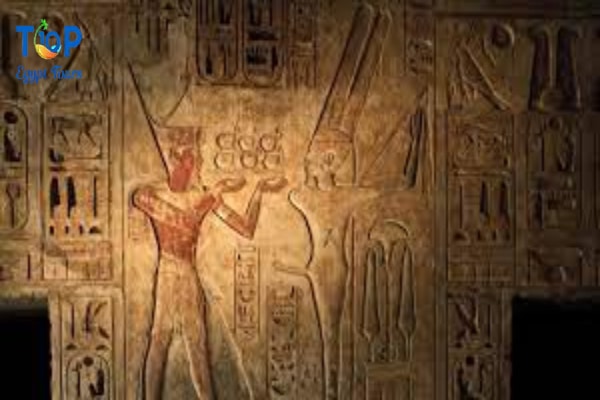Welcome to Top Ten Egypt Tours, where we embark on an extraordinary journey through ancient Egyptian mythology. In this captivating expedition, we invite you to unravel the legends and mysteries surrounding the mischievous god Min, the symbol of fertility and virility. Join us as we delve into the intriguing tale of this enigmatic deity and explore the profound significance he held in ancient Egyptian culture.
God Min Symbol of Fertility, often depicted as a male figure with an erect phallus and a crown adorned with tall feathers, embodied the essence of fertility, abundance, and masculine power. He played a vital role in the ancient Egyptian pantheon, influencing various aspects of life from agriculture to sexuality. Let us embark on an adventure into the world of Min and discover the intriguing customs, rituals, and beliefs associated with this captivating god.
The Symbolism of God Min Symbol of Fertility: Fertility and the Power of Nature
At the heart of Min’s symbolism lies the concept of fertility—an attribute that held great importance in the agricultural society of ancient Egypt. Associated with the natural cycles of birth and growth, Min represented the abundance of crops, ensuring the prosperity of the land and the sustenance of its people. The god’s phallus symbolized the regenerative power of nature and the life force that flowed through all living beings.
Egyptians revered Min as the patron of agriculture, attributing the success of their harvests to his blessings. Farmers would often seek the protection and guidance of Min, performing rituals and offering their prayers to ensure bountiful yields and a thriving land. The god’s influence extended beyond the fields and into the intimate aspects of human life, representing the virility and sexual potency of men.
The Cult of Min: Celebrations and Festivals of Fertility
The worship of God Min Symbol of Fertility involved elaborate celebrations and festivals, filled with joyous revelry and expressions of fertility. The most famous festival dedicated to Min was the annual “Festival of the Phallus,” a lively event where Egyptians celebrated the god’s influence on agricultural abundance and the vitality of human life.
During the festival, the streets would come alive with colorful processions, music, dancing, and theatrical performances. Participants would wear masks and adorn themselves with phallic symbols, embracing Min’s association with virility and fertility. The festivities celebrated the cyclic nature of life and the interconnectedness of human existence with the natural world, reinforcing the bond between Egypt’s people and their gods.
Min’s Legacy: Art, Amulets, and Talismans
Artistic depictions of Min provide invaluable insights into the god’s significance and the ancient Egyptians’ beliefs. Sculptures, paintings, and carvings often portrayed Min accompanied by his consort, the goddess Iabet, symbolizing the union of male and female energies and the balance necessary for fertility. These artistic representations offer a glimpse into the role Min played in everyday Egyptian life, reminding us of the enduring legacy he left behind.
Amulets and talismans featuring the likeness of Min were treasured by the ancient Egyptians, believed to bestow fertility and protection upon the wearer. These small relics, crafted in precious materials such as gold and faience, served as personal connections to the god’s power and were often worn as symbols of luck, strength, and vitality.
Unveiling Min’s Sacred Sites: Exploring Ancient Egypt’s Hidden Gems
To truly immerse yourself in the wonder of Min’s divine presence, we invite you on a captivating journey through the sacred sites associated with this playful fertility god. From the awe-inspiring Karnak Temple in Luxor to the enigmatic desert landscapes of Akhmim, these hidden gems offer glimpses into the ancient rituals and beliefs centered around Min.
Visiting the Temple of Min at Akhmim, dedicated to the god and his consort, Iabet, allows you to immerse yourself in the ambiance of ancient religious practices. Marvel at the intricate carvings and hieroglyphs that adorn the walls, telling stories of fertility and abundance. Explore the ruins of Koptos, where a shrine honoring Min once stood, and marvel at the remnants of a bygone era, where Min’s influence was deeply felt.
Embracing Min’s Legacy: A Journey through Ancient Egypt’s Fertile Heart
As you travel through Egypt, let the spirit of Min guide you on a remarkable adventure that combines exploration, history, and spirituality. Walk in the footsteps of ancient Egyptians, marvel at the awe-inspiring architecture, and awaken your senses to the vibrant echoes of a civilization shaped by the power of fertility and abundance.
From the lush greenery of the Nile Delta to the arid beauty of the Western Desert, Egypt offers a tapestry of landscapes that bear witness to the divine influence of Min. Experience the wonders of the fertile heart of Egypt, where life blooms, and the legacy of Min continues to captivate and inspire.
Min, the charismatic god of fertility and virility, holds a mesmerizing place in ancient Egyptian mythology. As the symbol of abundance and the life force of nature, Min’s influence permeated every aspect of Egyptian society, from agriculture to the intimate spheres of human existence. Journey with us through Top Ten Egypt as we unravel the mysteries surrounding this mischievous deity and encounter the sacred sites that bear witness to his enduring and captivating presence. Discover the profound connections between Egypt’s landscapes, customs, and beliefs, and unlock the secrets of Min’s legacy—a testament to the eternal bond between human life and the abundant forces of nature.



Comment (0)